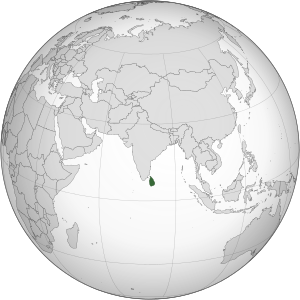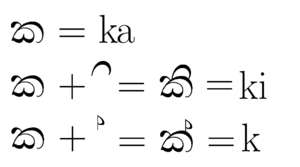Introduction ~ හැඳින්වීම
to learn this language. This introductory lesson will explain you the very basic things that you should know.

Introduction[edit | edit source]

Sinhala (සිංහල), also known as Sinhalese in English, is the native language of the Sinhalese people who constitute approximately 75% of the population of Sri Lanka and number greater than 15 million. Sinhala is also spoken as a second language by about three million people from other ethnic groups in Sri Lanka. It has evolved over the course of more than 2,300 years. Sanskrit and Pali are ancestor languages of Sinhala. It belongs to the Indo-Aryan branch of the Indo-European languages, and has been influenced by Dravidian languages such as Tamil and less so from a few other Indo-European languages: English, Dutch, and Portuguese.
Etymology[edit | edit source]
According to legend, Sinhabahu or Sīhabāhu (meaning, "Lion-arms") was the son of a princess of the Kalinga Kingdom and Sinha* (meaning, "Lion"; *he is described as a lion;). Sinhabahu killed his father who was harming the people of Kalinga and became the king of Kalinga. Prince Vijaya was his son who was exiled because of his impropriety and sailed to Sri Lanka with his troops. The term Sinhala comes from Sanskrit and is based on the mythological story of Prince Vijaya who is also the mythological founder of the Sinhalese nation. In some versions of this story, he is introduced with the name Simhala and as the son of Sinha. So, both the nation and the language are named from "Sinhala". There are lot of definitions for the etymology of the name Simhala, but none of them are considered official. However, it is agreed that it has a connection with the word Sinha (meaning, "Lion").
History[edit | edit source]

Although Sinhala is an Indo-European language, it has some unique features that set it apart from other Indo-Aryan languages. Some of the differences can be explained by the substrate influence of the parent stock of the Vedda language1. Sinhala has many words that are only found in Sinhala, or shared between Sinhala and Vedda and not etymologically derivable from Middle or Old Indo-Aryan.
The oldest Sinhalese Prakrit inscriptions found are from the 3rd to 2nd century BCE following the arrival of Buddhism in Sri Lanka; the oldest existing literary works date from the 9th century CE. Because of the arrival of Buddhism, Sri Lanka has been effected by the Indian culture and has relinquished most of the aboriginal Vedda culture which has almost completely disappeared now. Because of this situation, Sri Lanka became a country with Indo-Aryan culture which is surrounded by the Dravidian culture of South India. This has made Dravidian languages (mostly Tamil) a major influence of Sinhala.
Stages of historical development[edit | edit source]
The development of Sinhala is divided into four periods:
- Sinhalese Prakrit (until 3rd century AD)
- Proto-Sinhala (3rd - 7th century AD)
- Medieval Sinhala (7th - 12th century AD)
- Modern Sinhala (12th century — present)
Written Sinhala and Spoken Sinhala[edit | edit source]
There is a large difference between written and spoken Sinhala. Written Sinhala has a strict standard, but spoken Sinhala doesn't. So spoken Sinhala is easier to learn than written Sinhala. Even though this book has been written to teach how to speak, read and write, its priority is to teach written Sinhala. The following passage has some very important information about the writing system and pronunciation, so please read it carefully and study it well.
Writing System and Pronunciation[edit | edit source]
Sinhala is written in Sinhala script, which is an abugida, where only the consonants are independent letters and the vowels are indicated with diacritics (pillam; පිල්ලම්, vowel strokes) on those consonants. However, vowels are written as full letters when they occur word-initially, including in some compound words. Each consonant without a vowel stroke has an "inherent vowel", either /ʌ/ or /ə/, depending on the position of the consonant within the word. Vowel strokes are used to change the inherent vowel to another vowel sound. When a consonant has no vowel sound, the consonant is written with a sign called hal kirīma (හල් කිරීම) on it which removes the inherent vowel. So, a consonant-vowel pair is written as a single character: a letter plus an optional vowel stroke which changes the vowel sound, or in the case of the hal kirīma, removes the vowel sound.
The inherent vowel is pronounced /ʌ/ when stressed (the first vowel in a word, before a consonant without an attached vowel, and certain other situations) and /ə/ when unstressed. There are a few words which are exceptions to the normal rules of stress pronunciation.
Even though the writing system of Sinhala is an abugida, there were characters called "joined letters" (bandi akuru; බැඳි අකුරු) with three sounds combined that are rarely used now. They were used widely until the mid-twentieth century. These letters were written when the first letter is a consonant without a vowel and the second is a letter with a consonant and a vowel.
The alphabet[edit | edit source]
The alphabet (actually an abugida) will be extensively described in the next lesson. There are 18 vowels and 42 consonants in the alphabet. Keep in mind that there are some letters that are not included in the alphabet and some letters that are unused. The alphabet has many versions since ancient times and there are different modern versions that are proposed. However, the standard Sinhala alphabet is the one from the Sri Lankan National Institute of Education (NIE).
How should I start?[edit | edit source]
There is no need to write long paragraphs at the start, because you just need to understand these lessons and go ahead. Don't worry too much about your progress in learning this language. It'll be very easy to understand if you start from the basics. Even though Sinhala is an Indo-European language, as is English, it is very far from English geographically and linguistically. So, its structure is very different from English. Although there aren't many online sources for you to learn Sinhala, this book will be enough to learn the basics. You can learn how to write Sinhala letters from YouTube videos and other online sources. Get a paper notebook and write them again and again. Then, try to write them in more accurate shapes and sizes.
If you are familiar with IPA symbols, they will give you a better idea how to pronounce the words. In this wikibook, we use special signs for vowels to make these lessons easier. They will be introduced to you in the vowel chart of the next lesson. Also, every word written in Sinhala script will be followed by its pronunciation written in English (Latin) characters.
This book is designed with lessons in four stages. Basic lessons will make you ready to advance to the next stage. Each lesson of the second stage will have its own vocabulary and exercises. So, study well and have fun! Also, don't forget to read the DID YOU KNOW fact in every lesson.
The ruined city of Anuradhapura is one of the oldest sites in Sri Lanka where Brahmi writing on pottery dating from the 6th century BCE has recently been found with the title 'Anuradha' scratched on it. According to Mahavamsa, Anuradha is the founder of the Anuradhapura city. The term pura means city in Sinhala.
Notes[edit | edit source]
- 1.^ Vedda is the language of the aboriginal people of Sri Lanka. The parent Vedda language is of unknown genetic origins. Studies indicate that modern Vedda is a creole which evolved from ancient times, when the Veddas came in contact with the early Sinhalese, from whom they increasingly borrowed words and synthetic features, yielding the cumulative effect that Vedda looks like Sinhala in many particulars, but its grammatical core is still intact.
